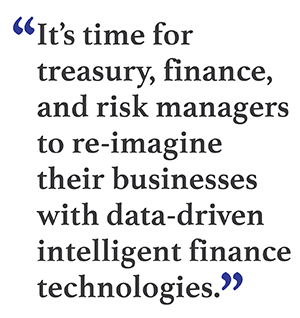
The use of technologies such as artificial intelligence (AI), robotic process automation (RPA), advanced analytics, and machine learning is transforming treasury management. For example, when applied to cash management processes, these technologies can help a retailer better understand how a weather event might impact future sales so that it can adjust accordingly. Or when these technologies are applied to liquidity issues, they can help treasury find patterns in historical and transaction data, then synthesize that information to determine where and how to make improvements.
In combination, these technologies are revamping all kinds of processes that used to be painstakingly manual and error-prone, enabling treasury staff to focus on areas that require greater interpretation or judgment. In fact, Accenture research has found that 80 percent of the activities of the typical corporate finance team can be automated using these tools. Such automation facilitates improvements in compliance and control, productivity, and cost.
An intelligent finance infrastructure can bring great benefits to leaders who are juggling everything from bank statements to payroll processing to bank reconciliation. Put simply, automation—as facilitated by these technologies—takes the headache out of analyzing and optimizing a wide range of finance chores that can be quite labor-intensive if completed manually. When applied effectively, AI, RPA, and related technologies enable treasury and risk management teams to work faster, more accurately, and with less complexity.
Access to More Valuable Data
One of the most exciting recent leaps in financial technologies is the way in which they empower finance professionals to overcome data silos. Many finance groups suffer from an information architecture in which isolated collections of unstructured data are disorganized and inaccessible to other parts of the organization. Companies often maintain a wide range of disjointed data stores that don't "talk" to one another. Siloed information might come from internal source systems, second-party cooperative ventures, and third-party organizations to which the company has data subscriptions.
So, how are new technologies helping? They're making cross-functional information more actionable by standardizing business processes, forcing adoption of data standards, and centralizing systems. The now-accessible data empowers finance professionals to mine diverse information sources for insights and automatically cull internal and external data related to such factors as market prices and exchange rates, social media sentiment analysis, customer relationships and web traffic, risk and compliance requirements, operations issues up and down the supply chain, and macroeconomic trends.
Sourcing the right data is key. Intelligent finance systems require a wealth of historical information. That's why it's important to start by pulling in cloudscape external data—such as macroeconomic data, commodities data, commodity indices, and historical trends in foreign exchange (FX) rates—then layering in internal organizational data on top of it.
The ability to tap rich and intricate data sets equips finance and risk management teams to assess plans and strategies objectively. Ultimately, this can lead to better strategic decision-making because treasury and finance leaders can develop more thorough analyses of both the risks and projected rewards of potential investments, supplier relationships, cash management policies, etc.
All the Right Data, in One Place
Once treasury and finance managers have access to an assortment of valuable data sources, they need to consolidate this information so that it's easily within analytical reach. In a recent survey of CFOs, Accenture found that 53 percent of finance executives worry that their function is reactive and that information-sharing processes are not streamlined. Nearly half (46 percent) expect to still feel this way in two years.
Machine learning–enhanced automation offers a means of pulling together information from disparate sources, without requiring treasury, finance, and risk teams to manually integrate mismatched sets of data. Instead of reconciling the data as they go, they can correct their master data files, then leverage an intelligent finance system to disseminate updates quickly and systematically. For example, a finance team might use these technologies to spot payment patterns that are outliers in the outgoing cash flows. They could then check flagged payments for fraud, errors, or updates before initiating the transaction, and could update master data files accordingly (e.g., reflecting terms that include discounts for on-time payment). Within accounts receivable, machine learning technologies could use data from various systems to forecast sales, cash flows, and demand.
Moreover, when a finance team pulls data from a wide range of source systems into a single repository that can serve as the company's "single version of the truth" for FX, interest rates, or other types of treasury data, intelligent finance solutions have the power to run reports and analyze data in real time, without questions about the quality of the data source. Treasury and finance teams can use these systems to drive value, boost productivity, and improve their strategic contribution. Ultimately, they can use these technologies to help their companies gain a competitive edge.
More Agile Business Decision-Making
The high-capacity automation in intelligent finance technologies adapts in real time to support completion of tasks, processing of intercompany reconciliations, and optimization of payables and receivables. Such automation can free treasury, finance, and risk managers from manual tasks, giving them more time to focus on other initiatives, such as optimizing cash flows and making financial investments for the future.
 Consider the time- and analysis-intensive budgeting and planning cycle. Some estimates suggest 50 percent to 60 percent of budgeting and planning can be automated. Leveraging this type of advanced technology, organizations can build long-range planning models with scenario analysis capabilities to model strategic goals. What's more, these automated systems can help employees more accurately complete judgment-oriented tasks like early-stage detection of fraud and payment mistakes.
Consider the time- and analysis-intensive budgeting and planning cycle. Some estimates suggest 50 percent to 60 percent of budgeting and planning can be automated. Leveraging this type of advanced technology, organizations can build long-range planning models with scenario analysis capabilities to model strategic goals. What's more, these automated systems can help employees more accurately complete judgment-oriented tasks like early-stage detection of fraud and payment mistakes.
AI can also help treasury and finance leaders better foresee opportunities to reduce and hedge against their company's financial risks. For example, within multicurrency or FX transactions, increased automation and real-time reporting enable treasury teams to rationalize account structures and simplify workflows. These technologies help treasury and finance teams make more useful connections, learning and adjusting as they go.
What's really promising is that an intelligent finance operating model empowers stronger decision-making across the board. Leaders will get a macro view of interest rates, tax impacts, and other crucial global factors. Stronger, more informed decisions around where to pay off debt or take out loans, for example, will follow.
Get Ready for Intelligent Finance
Treasury and finance leaders who are preparing to make the leap to a data- and AI-driven intelligent finance model should evaluate the prospective improvements along several dimensions. They can ask themselves:
- What do I want to understand about my organization's working capital needs?
- How can I better partner with my company's business and operating units to close the gaps between sales and collections, and between procurement and payables?
- How can I work more closely with departmental heads throughout the company to understand their capital needs, upcoming projects, and desired investments, so that cash forecasts and risk hedges are optimized companywide?
- How can I understand the plans of the manufacturing and sales groups?
- How can I partner effectively with business managers to get a good understanding of pricing?
- In what areas could predictive analytics improve forecasts?
As you embark on this journey, it's also important to ensure that your plan for technology transformation will fully integrate the intelligent finance software across the entire finance organization, throughout all departments and levels of management. You will need a cross-departmental system in place to support centralization of treasury and finance processes, so dedicate adequate energy to educating those whose buy-in the project requires. It's also important to ensure that staff who will be expected to leverage intelligent finance have the skills and training to achieve best practices. The most pressing and pervasive challenges around these technologies relate to the human learning curve.
Another key consideration in setting the stage for an intelligent finance transformation is to work with the company's banking partners to ensure that all accounts readily feed data into the digitized system. Establishing optimal visibility and control over all bank account balances, from a central location, paves the way for accurate cash flow forecasting.
Ensure that risk management is consistent and easily replicable across the organization. And, finally, be sure to establish key performance indicators (KPIs) to measure the company's progress toward treasury-related performance goals.
Looking Ahead
It's time for treasury, finance, and risk managers to re-imagine their businesses with data-driven intelligent finance technologies. When they do, they can take their organization from transactional to strategic. And when they champion the use of sophisticated intelligent finance technologies at every level of their function, they also drive efficiency, improve decision-making, and pave the way for a more intelligent operating model that multiplies value and growth.
Are you ready to begin your organization's digital transformation journey?
 Manoj Shroff is the managing director for finance and accounting business process services lead for Accenture Operations. In this role, he helps transform finance functions from transactional to strategic using data, intelligent technologies, and talent.
Manoj Shroff is the managing director for finance and accounting business process services lead for Accenture Operations. In this role, he helps transform finance functions from transactional to strategic using data, intelligent technologies, and talent.
© 2025 ALM Global, LLC, All Rights Reserved. Request academic re-use from www.copyright.com. All other uses, submit a request to [email protected]. For more information visit Asset & Logo Licensing.




